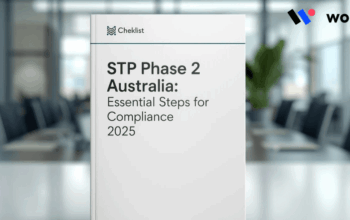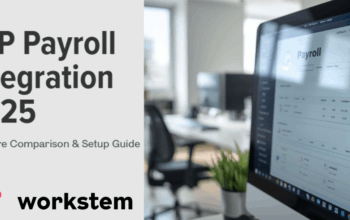Navigating the complexities of Single Touch Payroll (STP) Phase 2 can be a daunting task for any Australian business. For companies relying on manual processes, the transition often means increased stress, compliance risks, and administrative headaches.
This case study explores how Workstem partnered with a mid-sized manufacturing business to streamline their STP migration, turning a regulatory challenge into a story of efficiency, accuracy, and significant cost savings.
Background: The Compliance Chaos in a 150-Employee Manufacturing Business
Our client, an established manufacturer with 150 employees, was grappling with the limitations of a fully manual payroll system. As STP Phase 2 requirements came into effect, their existing processes became a significant liability.
Key challenges included:
- Manual Data Entry: HR staff spent hours each pay cycle manually calculating pay, taxes, and superannuation, increasing the risk of human error.
- Frequent ATO Queries: Discrepancies in their STP submissions often led to follow-up questions from the Australian Taxation Office, requiring valuable time to resolve.
- High Compliance Stress: The fear of missing deadlines or submitting incorrect information was a constant source of anxiety for the finance team.
- Lack of Visibility: Reporting was time-consuming, making it difficult to get a real-time view of payroll data and labour costs.
They needed a robust, ATO-compliant solution that could automate their STP reporting and integrate seamlessly with their existing operations.
The Migration Process: A Seamless 4-Week Transition Timeline
The shift to a new system was methodical and efficient, completed in just four weeks with minimal disruption.
Week 1: System Selection & Planning
After evaluating several providers, the client chose Workstem for its dedicated AU payroll expertise, native STP Phase 2 compliance, and user-friendly interface. We established a clear project plan and timelines.
Week 2: Data Cleanup & System Configuration
Our team worked closely with the client’s payroll officer to clean historical employee data. We then configured the Workstem platform to their specific awards, pay conditions, and reporting needs.
Week 3: Integration & Testing
Workstem integrated with their existing accounting software. We ran multiple parallel pay runs to test accuracy and ensure every data point—from ordinary earnings to allowances and bonuses—was correctly categorised for STP Phase 2.
Week 4: Employee Training & Go-Live
We conducted tailored training sessions for the HR and finance teams, empowering them to confidently run payroll and generate reports. The system went live successfully ahead of the next pay cycle.
Results: 80% Time Savings and Zero Compliance Issues
The impact of implementing Workstem was immediate and quantifiable.
- 80% Reduction in Admin Time: The payroll process was slashed from several hours to under 30 minutes per cycle. Automated calculations and pre-fill ATO submissions eliminated manual data entry.
- Zero ATO Compliance Issues: With Workstem’s ATO-approved platform, every submission was accurate and on time. The constant back-and-forth with the ATO ceased completely.
- Enhanced Data Accuracy: Automated checks ensured 100% accuracy in pay calculations, super payments, and tax withholdings, boosting employee trust.
- Real-Time Reporting: Management gained instant access to detailed labour cost reports, enabling better financial decision-making.
- Lessons Learned: Critical Success Factors for STP Migration
This successful migration highlighted several key factors for a smooth transition:
- Proactive Change Management: Clear communication from leadership about the benefits of the new system ensured company-wide buy-in.
- Employee Training & Support: Investing time in training payroll staff was crucial for adoption and maximising the platform’s potential.
- Choosing the Right Partner: Selecting a provider like Workstem, which offers dedicated local support and ongoing compliance updates, is essential for long-term success.
Cost-Benefit Analysis: $45K Annual Savings from Automation
Beyond compliance, the financial benefits were substantial. By automating payroll and eliminating manual errors, the client achieved:
- Direct Labour Savings: Recouping 10+ hours of administrative time per week allowed staff to focus on high-value strategic tasks.
- Error Elimination: Removing costly mistakes in over/under payments and superannuation contributions.
- Reduced Software Fragmentation: Consolidating systems with Workstem’s all-in-one platform reduced licensing fees for multiple disconnected tools.
The total calculated annual saving from automation amounted to approximately $45,000, delivering a powerful return on investment.
How Workstem Helps Manage STP Obligations?
Ensure your business remains compliant effortlessly. Let Workstem’s automated payroll and integrated STP Phase 2 reporting handle the complexity for you. Explore Workstem’s STP Solution today and ensure peace of mind with every pay run.
Simplify award interpretation and payroll processing with Workstem, the all-in-one workforce management & payroll software designed for every industry. Workstem is an ATO-approved STP Phase 2 solution that simplifies compliance by automating the entire process:
- Built-in Validation: Workstem’s software is designed with the correct STP Phase 2 fields and categories, guiding you to enter data correctly and reducing errors.
- Seamless Integration: As an all-in-one platform, Workstem integrates time & attendance, payroll, and STP reporting. This eliminates manual data entry between systems, ensuring the data you report is accurate and consistent.
- Easy Submissions: Reporting is done with a single click at the end of each pay run, with immediate confirmation from the ATO.
- Simplified Finalisation: The year-end finalisation process is streamlined and can be completed in minutes.
Choose from our Standard or Advanced plan to suit your business needs, and stay Fair Work compliant with confidence.
FAQs About the Single Touch Payroll (STP)
Q1: What is Single Touch Payroll (STP) in simple terms?
A: Single Touch Payroll (STP) is a mandatory Australian government initiative that requires businesses to report their employees’ payroll information—such as salaries, wages, pay-as-you-go (PAYG) withholding, and superannuation—to the Australian Taxation Office (ATO) directly from their payroll software each time they run payroll. It’s “single touch” because the reporting happens with a single action at the same time as you pay your staff.
Q2: Who needs to report through STP?
A: Essentially, all Australian employers must report through STP.If you have even one employee, you are generally required to use STP.
Q3: What is the difference between STP Phase 1 and STP Phase 2?
A: STP Phase 2 expands the reporting requirements introduced in Phase 1. The key difference is the level of detail provided to the ATO.
- STP Phase 1 reported total amounts for key figures like gross earnings and tax withheld.
- STP Phase 2 requires a detailed, disaggregated breakdown of an employee’s income (e.g., separating salary, overtime, allowances, and leave payments).
Q4: What are my ongoing STP reporting obligations?
A: Your main ongoing obligations are:
- Report Each Pay Event: Submit the required data to the ATO on or before every pay day.
- Year-End Finalisation: Finalise your data by 14 July each year. This declares the information for the financial year is complete and correct. This replaces the need to provide payment summaries to your employees.
- Keep Records Accurate: Ensure employee details in your payroll software are always up-to-date (e.g., tax declarations, super fund choice).
Q5: I missed the STP Phase 2 migration deadline. What should I do?
A: You should take action immediately:
- Contact your software provider to start the transition process.
- Lodge a voluntary disclosure with the ATO to explain the delay. The ATO generally looks favorably upon businesses that come forward voluntarily and may provide you with a compliance plan or extra time to transition.
- Ensure you are using an ATO-approved STP Phase 2 solution, like Workstem, to become compliant.
Q6: How does STP help with my employees’ Superannuation?
A: While STP itself does not pay your super, it reports the liability for superannuation to the ATO each payday. This allows the ATO to better monitor and ensure that employers are meeting their super guarantee obligations on time. You still need to pay your super contributions to your employees’ funds by the quarterly due dates.
Q7: Does STP change when I have to pay my tax and super?
A: No. STP is a reporting system, not a payment system. The due dates for paying the PAYG withholding tax you report to the ATO and your super guarantee contributions to funds remain unchanged.
Q8: What happens if I make a mistake in my STP report?
A: Mistakes can be fixed. If you discover an error in a past submission, you can make a STP amendment through your payroll software. You simply correct the information in your system and submit a revised update to the ATO. It’s important to correct errors as soon as you find
Q9: Where can I find official information from the ATO?
A9: The best source of truth is always the official ATO website. You can find comprehensive guides, news, and resources on their Single Touch Payroll for employers page.
Book a free demo with our payroll experts and experience how Workstem can streamline your payroll and workforce operations.
Read More:
STP Phase 2 Australia: Post-Migration Compliance Guide & Requirements
Single Touch Payroll 2025: Everything Australian Employers Need to Know
Avoiding STP Penalties 2025: ATO Audit Guide & Risk Prevention
Guide to Single Touch Payroll for Closely Held Payees








